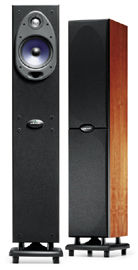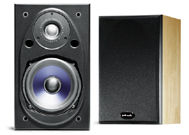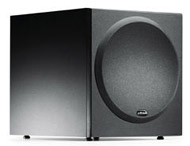|
September 2000 Polk Audio Home Theater System A few years ago Polk Audio revamped their line and introduced the RT series of high-performance, high-value speakers. The new line ran the gamut from small stand or wall-mount to large floorstanding speakers with built-in powered subwoofers. Many of these garnered critical acclaim. Well, Polk has been at it again. This time, rather than the creation of an entirely new line, they have reworked the existing line using new drivers throughout while tweaking the overall performance. I applaud their decision to maximize existing designs rather than to start from scratch and create an entire new line of speakers just to appease the "newer is better" crowd. Polk is going a step further and, for about the same price as the preexisting line, is using real wood veneers to finish the speakers rather than the vinyl wraps of yore. The model designations within the line have pretty much remained the same, but the new speaker models carry the "i" addendum. So, armed with a complete home-theater system it was time to revisit the house of Polk and see what their efforts have wrought.
First up is the new RT1000i floorstanding tower speaker, which incorporates an internally powered subwoofer. Actually, with response down to 36Hz, it’s not exactly kosher to refer to it as a subwoofer. It would be more accurate to refer to it as a powered woofer. That is not to downplay the performance of these speakers in any way, or to minimize the importance of such a design in a home theater featuring an A/V receiver of modest power. Indeed, the use of a speaker with a powered woofer section is like injecting steroids into such a humble system, as the receiver is now freed of the burden of producing bass, the most burdensome task asked of any power amplifier. The amplified woofer section also introduces a degree of flexibility not found in passive systems, because you can adjust the volume of the bass to suit both the room and your tastes. My review samples were finished in dark cherry and were very nicely done. The new wood veneers take what was already a very nice looking design to the next level. But that’s not what makes the new speaker better than its predecessor. For that we need to look behind the speaker’s grill to find all-new drivers. The new cobalt-blue midbass driver is a clear hint that things have changed, and while the tweeter looks the same as it did last year, it is a newly refined design. I’m happy to report that the new RT1000i is much-improved. The speaker is much cleaner through the midband and more natural to boot, with a smoother and more natural treble. If I had to criticize the RT1000i (and I guess it’s expected that I do), I would have to point to two things. First, the bass is not exactly rock solid and second, the midrange is less than ultra detailed, lending an almost too easy-going personality. Regarding the bass, one needs to keep things in context; this is a very inexpensive speaker. The RT1000i sits proudly among a slew of mini-monitors that not only don’t have its bass extension, but also don’t offer its power, output, and flexibility. So while there’s room for improvement in absolute terms, considering its competition and price, I believe it deserves a little slack. Regarding midrange resolution, again this is an inexpensive speaker, which tries to do everything and accomplishes its goal to a reasonable extent considering its class. If better detail is what you seek, you can find better monitors on the market, but be prepared for a trade-off in other areas of performance. For example, the ACI Sapphire III is an excellent monitor speaker that sells for $999 factory direct. Head-to-head and out of the gate, the Polk jumps to an early lead with its bass performance. The Sapphire just can’t compete due to its smaller cabinet. The Polk is also more flexible because you can adjust the level of the bass to suit your room and tastes. Overall tonal balance is actually rather similar between the two speakers with the Polk being just a touch more forward in the upper-midrange, which brings female vocalists just a bit more forward in the mix than does the Sapphire. The Polk’s midrange is still a bit colored by comparison and female vocals suffer a slight cupped-hands coloration. The 1000i just doesn’t have the natural transparency that the ACI speaker does. In the treble the Sapphire just edges the Polk in ultimate refinement. I must stress, however, that this is really an unfair comparison. These two speakers are really apples and oranges. While the Sapphire concentrates on the midrange and treble, for around the same money or less, the Polk gives a more full-range performance and must make some sacrifices along the way. If you have the budget for something better, I highly recommend you look at Polk’s RT2000i. It costs considerably more but it’s money well spent. The old RT2000p had very quick and solid bass with relatively high output and a more revealing and engaging midrange. If the treble is as improved as it is in the speakers under review, the RT2000i is going to be a speaker to be reckoned with. If your budget restricts you to the price of the RT1000i, as I say, you can look around, but there will always be compromises to be made. CS245i
RT25i
PSW 350 Subwoofer
On the other hand, music and concert videos proved the PSW 350 a much more satisfying performer. Switching between the Polk and the Avatar proved to be much less revealing of differences. Charged with the duties of reproducing bass drum and electric bass, the PSW 350 did just about everything I would expect of such a small budget-priced subwoofer. I went so far as to match the PSW 350 with a variety of monitor speakers, all selling for many times the price of the Polk subwoofer, in a two-channel music system. I was impressed with its prowess as a musical-sounding sub. Just as with the RT1000i, the PSW 350 proved that you get what you pay for, and better performance can be had from a larger and more powerful subwoofer with a commensurately higher price tag. If you have a small budget or a small room however, the PSW 350 may be all you need or want. Without question, as a system in the theater, this Polk ensemble succeeds. Working in conjunction with my Yamaha DSP 1A, the sound was always smooth and inviting. With all the pieces working in concert, dynamics were surprisingly good for what is a fairly entry-level system. All the pieces are well matched for timbre, and considering the fact that they were not designed as a packaged system, I have to offer real kudos to the engineers at Polk. Bombastic and dramatic sound effects can be fun, but sometimes the magic can be found in the subtle details. Following the shoot-out in front of the restaurant in Analyze This, the movie dissolves to a setting in the suburbs. The scene opens with a view of a house as seen from across the well-manicured lawn. The leaves in the trees are rustling in the breeze and a real sense of tranquillity contrasts the previous inner-city shoot-out frenzy. The scene works superbly due to the soundtrack, which the Polk system does complete justice to. Delicate and even subliminal though it may be, the breeze working its way through the surrounding trees is something that most people have experienced in real life (as opposed to the sound of a car bomb!), and is an easy sound for most listeners to relate to. Over the Polk system the scene works because it sounds so real. Speaking of the sounds of nature, the thunderstorm scene from The Edge sounds equally authentic. Again, the timbre-matched speakers provided a coherent and omnipresent sense of real thunder and rain. The powerful thunderclap was not one of the events that showed the PSW 350’s limits. Delightfully, the PSW 350 was well equipped to energize my 23 by 17-foot room. The frequent helicopter fly-overs from Godzilla were equally well portrayed over the Polk system. Again, the PSW 350 was able to handle the bottom end to a convincing degree, while the synchronous nature of all the speakers working in concert provided a consistent auditory view of the helicopters as they panned across the room. Tom Petty’s High Grass Dogs Live At The Filmore sounded great over the Polk system. Bass lines were clean and sharp with a realistic heft. Drums sounded clean and fast but their lack of weight owed to the recording, not the Polk system. Guitars sounded clean with just the right amount of bite, and each guitar used on stage clearly sounded different from the one that preceded it Conclusion Dissecting this Polk theater system and comparing it piece-by-piece with other Polk systems that I've had intimate contact with, including the outstanding RT5000, clearly shows that I've descended the ranks into the more affordable realm. As compared to the components used in the much more expensive RT5000, each part of this system proved to be designed for a lower price point, and had a commensurately lower level of performance. Gratefully and somewhat surprisingly, when taken as a system, the package under review comes much closer to the performance of the more expensive systems than I would have expected. For a speaker system with a list price of less than $2200, the system had remarkably few flaws and a great many strengths including great looks, a clean midband and smooth, non-fatiguing sound overall. As a system, bass was generally clean and articulate and dynamics were very good. All in all, I consider this system a real achievement for the meager asking price and a very satisfying performer in absolute terms. At once I congratulate Polk on a job well done on the reengineering of the RT line of speakers. I recommend to anybody shopping for speakers in this price range (and even above) to check out Polk’s latest offerings. As the old cliché goes, if you haven’t heard Polk lately, you haven’t heard Polk! ...John Potis Manufacturer Contact: Website: www.polkaudio.com GO TO |
||||
| Copyright
© 2000 SoundStage! All Rights Reserved |
![[SOUNDSTAGE!]](../../titles/sslogo3.gif) |
 RT1000i
RT1000i The CS 245i is Polk’s
middle-of-the-line center-channel speaker. It uses two of the slightly smaller versions of
the midbass drivers used in the RT1000i as well as the tweeter in an MTM
(midrange/tweeter/midrange) arrangement. The CS245i remains clad in black pebble-grained
vinyl. I was generally pleased with the performance of the CS245i. It had good clarity and
it was an excellent match for the RT1000i. Dynamics were quite satisfying for a speaker in
its class. At no time did I feel the larger RT1000i was leaving it in the dust, or that it
was holding the system back. Turning it on and off during concert videos had surprisingly
little effect on the timbre of vocals, the major change being that of the solidity of the
center image -- just as it should be. The CS245i was more than detailed and transparent
enough to throw into sharp relief problems with movie soundtracks. For instance, scenes
from Analyze This where you could easily hear the effects of the vocal overdubs,
the voices went from chesty, to natural, to hollow and back. For example, listen closely
to scene 17, "Wedding Day Victims." The problems are easily discernible over the
CS245i, for better or worse.
The CS 245i is Polk’s
middle-of-the-line center-channel speaker. It uses two of the slightly smaller versions of
the midbass drivers used in the RT1000i as well as the tweeter in an MTM
(midrange/tweeter/midrange) arrangement. The CS245i remains clad in black pebble-grained
vinyl. I was generally pleased with the performance of the CS245i. It had good clarity and
it was an excellent match for the RT1000i. Dynamics were quite satisfying for a speaker in
its class. At no time did I feel the larger RT1000i was leaving it in the dust, or that it
was holding the system back. Turning it on and off during concert videos had surprisingly
little effect on the timbre of vocals, the major change being that of the solidity of the
center image -- just as it should be. The CS245i was more than detailed and transparent
enough to throw into sharp relief problems with movie soundtracks. For instance, scenes
from Analyze This where you could easily hear the effects of the vocal overdubs,
the voices went from chesty, to natural, to hollow and back. For example, listen closely
to scene 17, "Wedding Day Victims." The problems are easily discernible over the
CS245i, for better or worse. The new RT25i uses the same
midbass driver and tweeter used elsewhere while utilizing Polk’s Power Port
technology to extend low-frequency response. As with the previous model, the Power Port
mechanism on the rear of the speaker doubles as a wall-mount apparatus, which is
exceedingly handy. For variety sake, my pair was finished in Maple, which was quite
handsome and looked much more expensive than its asking price would imply. The original
RT25 was one of my favorite little inexpensive speakers. It had marvelous clarity, really
excellent bass for a speaker its size and was an excellent performer for the money. The
new RT25i is a little winner too. As I had on hand a pair of the original RT25s, I was
able to compare them side-by-side. I found the sound of the RT25i to offer a cleaner
midrange, which by virtue of a new and improved level of detail did a better job of
projecting vocals in particular. The same can be said for the treble; cymbals were
cleaner, clearer and better projected. In a side-by-side comparison, the older version now
sounded a little darker and closed-in compared to the more open and more transparent
RT25i.
The new RT25i uses the same
midbass driver and tweeter used elsewhere while utilizing Polk’s Power Port
technology to extend low-frequency response. As with the previous model, the Power Port
mechanism on the rear of the speaker doubles as a wall-mount apparatus, which is
exceedingly handy. For variety sake, my pair was finished in Maple, which was quite
handsome and looked much more expensive than its asking price would imply. The original
RT25 was one of my favorite little inexpensive speakers. It had marvelous clarity, really
excellent bass for a speaker its size and was an excellent performer for the money. The
new RT25i is a little winner too. As I had on hand a pair of the original RT25s, I was
able to compare them side-by-side. I found the sound of the RT25i to offer a cleaner
midrange, which by virtue of a new and improved level of detail did a better job of
projecting vocals in particular. The same can be said for the treble; cymbals were
cleaner, clearer and better projected. In a side-by-side comparison, the older version now
sounded a little darker and closed-in compared to the more open and more transparent
RT25i.  Reporting for bass duty was
the PSW 350 powered subwoofer, which is rather small and inconspicuous, as far as
subwoofers go. The PSW 350 subwoofer proved to be more difficult to sum-up and depending
on what you expect from a subwoofer, either it’s an unqualified success or it leaves
something to be desired. What it doesn’t do is plumb the depths of bass. With a
–3dB point of 38Hz, there is, even on video, some program material clearly beyond its
reach. I used the PSW 350 next to the more expensive, larger, and overachieving Avatar
Kali subwoofer. While the PSW350 proved to be fairly satisfying on its own, a direct
comparison against the larger Avatar threw the little Polk’s shortcomings into sharp
relief. The 350 could not match the Avatar’s rumble factor. It offered lots of bass
for the ears, but less for the seat-of-the-pants. Bomb-blasts and other bass-heavy
extravaganzas just sounded a little less dramatic and less powerful over the Polk.
Reporting for bass duty was
the PSW 350 powered subwoofer, which is rather small and inconspicuous, as far as
subwoofers go. The PSW 350 subwoofer proved to be more difficult to sum-up and depending
on what you expect from a subwoofer, either it’s an unqualified success or it leaves
something to be desired. What it doesn’t do is plumb the depths of bass. With a
–3dB point of 38Hz, there is, even on video, some program material clearly beyond its
reach. I used the PSW 350 next to the more expensive, larger, and overachieving Avatar
Kali subwoofer. While the PSW350 proved to be fairly satisfying on its own, a direct
comparison against the larger Avatar threw the little Polk’s shortcomings into sharp
relief. The 350 could not match the Avatar’s rumble factor. It offered lots of bass
for the ears, but less for the seat-of-the-pants. Bomb-blasts and other bass-heavy
extravaganzas just sounded a little less dramatic and less powerful over the Polk.